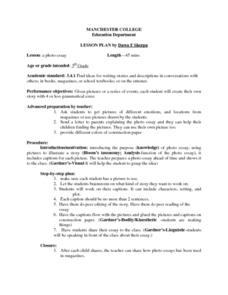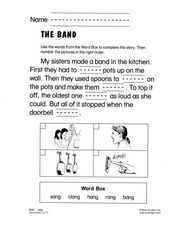Curated OER
It's Not Just Story Time... It's Learning Time!
Students look at picture books and describe the story elements. In this picture book lesson, students retell a story and begin to understand the story elements of plot, setting, and characters. Students complete graphic organizers to...
Curated OER
SEQUENCING A STORY WITH PICTURES: TEXT AND TALK
Third graders create a graphic organizer. They draw illustrations that show the beginning, middle and end of a trip they took to visit a friend or a relative. They write age-appropriate text to accompany each drawing. They tell...
Curated OER
Every Picture Tells a Story
Students explore story structure. In this literacy and story structure lesson, students listen to picture books and illustrate a favorite part of the story. Students share their pictures and place them in sequential order on a bulletin...
Curated OER
The Hole Story
In this filling in the blanks and sequencing learning exercise, learners use words from the word box to complete the sentences and number the pictures to show the order of events in the short story. Learners write 8 answers.
Curated OER
Story Boards
Students devise story boards to sequence the main events in a story. They draw a picture that demonstrates the main event in each chapter of a story and label it with a sentence.
Curated OER
A Photo Essay
Students analyze photographs, then create their own photo essays by using photos, magazine pictures or drawings to illustrate their stories.
Live Oak Media
Activity Guide: Joseph Had a Little Overcoat
Enhance a reading of the Caldecott Medal-winning children's book Joseph had a Little Overcoat by Simms Taback with this collection of learning activities. Starting with general background information about the book and author,...
Mary Pope Osborne, Classroom Adventures Program
The Backpack Travel Journals
Strap on those backpacks, it's time to travel through history with this literature unit based on the first four books of The Magic Tree House series. While reading through these fun stories, children create story maps, record...
Curated OER
The Beginning, The Middle, & The End
Cut magazine pictures into three sections, having your youngsters piece the pictures back together. With this fun activity, they discover the importance of sequencing a story. Then they use a fun template (shaped like a burger) to write...
Curated OER
In the Right Order
What comes first? Practice order of events with this sequencing activity. Learners examine two sets of pictures and write 1st, 2nd, and 3rd beneath the corresponding pictures. Encourage them to explain their reasoning, as there may be...
Curated OER
Old Lady That Swallowed a Fly
Youngsters listen to the story, "There Was an Old Lady Who Swallowed a Fly." After discussing the story, going over new vocabulary, and repeating the rhymes in the story, they study the parts of a fly. They finish by creating a fly on...
Curated OER
ELD Lesson Plan: Courage
What is true courage? Your class can explore the answer with these three Houghton-Mifflin stories ("Hatchet," "Passage to Freedom," "Climb or Die," and "The True Confessions of Charlotte Doyle"), which feature courageous characters and...
Curated OER
Story Sequence - Wrapping a Present
For this sequence of events worksheet, students number the four pictures in order from one to four to illustrate the sequence of wrapping a present.
Curated OER
Sweet Clara and the Freedom Quilt: The Real Story
Young scholars learn how slaves communicated with each other. In this slavery and freedom lesson, students learn how slaves used quilts as maps, learn what different quilt patterns meant, draw a picture for their class freedom...
Hawaiʻi State Department of Education
Story Design
Stories contain very specific elements; plot, characters, and key events. Learners use pantomime to retell a key event from the beginning, middle, and end of a story. They discuss setting and character as each group discusses and then...
Curated OER
The Lost Son Worksheet
In this religious education instructional activity, students view six illustrations that depict the story of The Lost Son. Students write a sentence to go along with each picture.
August House
Stone Soup
Sharing and cooperation are difficult skills for kindergartners to grasp. Using the story Stone Soup and a series of activities, kids learn about the benefits of working together, categorizing and comparing items, and eating...
Curated OER
Mitten Lesson Plan
Students compare The Mitten by Jan Brett to other versions of the same story, then create their own version. In this early childhood lesson plan, students create their own version of The Mitten, then use software to record a podcast. ...
Pennsylvania Department of Education
Tell Me Again
Students demonstrate how to retell a story in sequential order. For this reading comprehension lesson, students listen to a suggested read aloud, such as Little Boy Blue. Additionally, students practice retelling the story by using...
Curated OER
Sequence of Events Storyline
Seventh graders practice sequencing the events in a story they have read. After reading a short story, 7th graders sequence the events of the story using a timeline. Their timeline is used to create a summary paragraph of the story...
Curated OER
Sequencing
Second graders retell a story focusing on sequence. in this sequence activity, 2nd graders read the story Carry Go Bring Come by Vyanne Samuels. They retell parts of the story and put them in the correct order.
Curated OER
The Band
For this identifying words spelled with "-ang" activity, students use the word bank to fill in the blanks with -ang words and then number the pictures in order. Students write 9 answers.
Curated OER
Comprehension: Understanding "sequence"
Second graders read the story The Broken Bed and then sequence the story in their own words. In this sequencing lesson plan, 2nd graders also write narrative with a specific beginning, middle, and end.
Curated OER
When Did It Happen in the Story?
In this sequencing learning exercise, students answer multiple choice questions about the sequence of events in 2 stories they read. Students complete 10 questions total.
Other popular searches
- Story Sequence Pictures For
- Free Story Sequence Pictures
- Sequence Story Pictures
- Sequencing Pictures Story

























